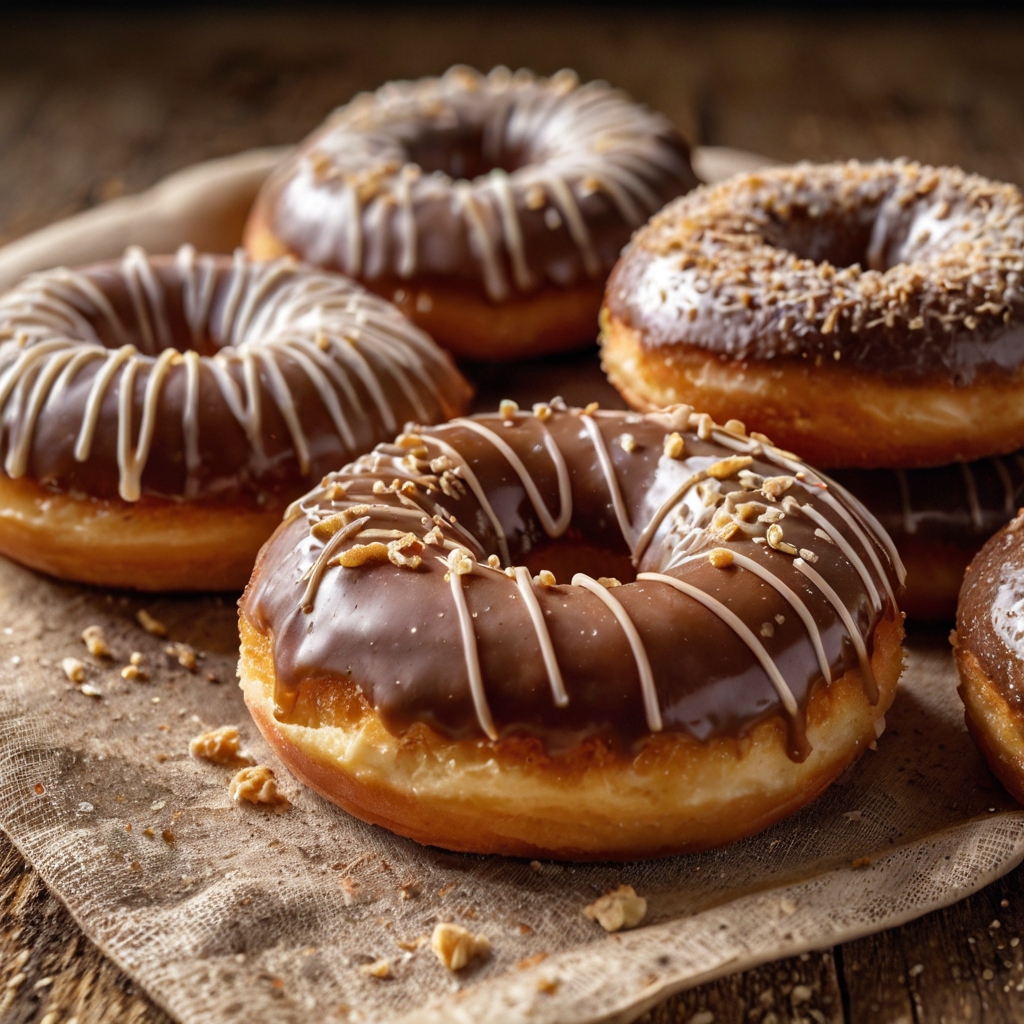Introduction
Gluten-free donuts have gained immense popularity as more people seek healthier and allergen-friendly options. But what makes these treats so special? For those with gluten sensitivities or celiac disease, avoiding gluten is essential for their health. Gluten-free donuts cater to these dietary needs while still offering the same indulgence as traditional donuts. From classic flavors to creative variations, these donuts have something for everyone. This guide delves into the world of gluten-free donuts, exploring their health benefits, ingredients, and how to make them at home.
What Makes Donuts Gluten-Free?
Understanding what sets gluten-free donuts apart starts with grasping the basics of gluten. Gluten is a protein found in wheat, barley, and rye. It provides elasticity and structure to baked goods, which is why it’s a key ingredient in traditional donuts. However, for individuals with gluten intolerance or celiac disease, consuming gluten can lead to severe health issues.
To make donuts gluten-free:
- Replace wheat flour with alternative flours like almond, rice, or coconut flour.
- Use natural binders such as xanthan gum or psyllium husk to replicate the texture of gluten.
- Avoid cross-contamination by ensuring equipment and ingredients are certified gluten-free.
These substitutes not only make donuts safe for those avoiding gluten but also open the door to creative flavor profiles and textures.
For more inspiration on incorporating gluten-free ingredients into everyday meals, check out this guide to Gluten-Free Chicken Nuggets and Sauces.
Health Benefits of Gluten-Free Donuts
Switching to gluten-free donuts isn’t just about avoiding gluten—it can also come with unique health benefits:
- Better Digestion
Gluten-free donuts are easier on the digestive system, especially for those with gluten sensitivities. Removing gluten can alleviate symptoms like bloating and abdominal discomfort. - Suitable for Allergies
Many gluten-free recipes use allergen-friendly ingredients, making them a safe choice for people with multiple food sensitivities. - Nutrient-Rich Ingredients
Alternative flours like almond flour are packed with nutrients, including healthy fats, protein, and fiber, which can make gluten-free donuts more nutritious than their traditional counterparts. - Reduced Inflammation
For individuals with gluten-related disorders, eliminating gluten can lower inflammation in the body, promoting overall health.
While gluten-free donuts can be a healthier option, they still contain sugar and fats, so moderation is key.
Ingredients Used in Gluten-Free Donuts
Creating the perfect gluten-free donut begins with selecting the right ingredients. Unlike traditional recipes, gluten free donuts rely on innovative substitutes to achieve the desired taste and texture.
Common Gluten-Free Flours
- Almond Flour: Adds a nutty flavor and is rich in protein.
- Coconut Flour: A low-carb option with a mild sweetness.
- Rice Flour: Provides a neutral base and smooth texture.
Natural Binders and Thickeners
- Xanthan Gum: Mimics the elasticity of gluten, ensuring the dough holds together.
- Psyllium Husk: Adds structure and helps maintain moisture.
Sweeteners and Flavor Enhancers
- Natural sweeteners like honey or maple syrup add depth to the flavor.
- Spices like cinnamon, nutmeg, or vanilla elevate the taste profile.
Using high-quality, certified gluten-free ingredients ensures the final product is both delicious and safe for consumption.
Types of Gluten-Free Donuts
Gluten-free donuts come in various styles, each catering to different preferences and dietary needs. Whether you crave a light and fluffy treat or something dense and satisfying, there’s a gluten-free donut for you.
Yeast-Raised Gluten Free Donuts
- Soft and airy, similar to traditional donuts.
- Made with yeast for a fluffy texture and mild sweetness.
- Often glazed or coated with sugar for a classic finish.
Cake-Style Gluten Free Donuts
- Dense and rich, perfect for pairing with coffee.
- Use baking powder or baking soda as a leavening agent.
- Popular flavors include chocolate, vanilla, and pumpkin spice.
Vegan and Low-Sugar Options
- Use plant-based milk and egg substitutes like flaxseed.
- Sweetened with natural alternatives such as stevia or fruit purees.
- Great for health-conscious individuals and vegans.
Each type offers a unique experience, allowing you to enjoy gluten free donuts in different forms
.For a comprehensive look at another gluten-free staple, explore this article on Oat Bagels and Their Gluten-Free Alternatives.
Homemade Gluten-Free Donuts
Making gluten-free donuts at home is easier than you might think. With the right ingredients and techniques, you can recreate bakery-quality treats in your kitchen.
Essential Equipment
- Donut Pan: For baked donuts with even shapes.
- Mixing Bowls: To combine dry and wet ingredients.
- Cooling Rack: Ensures the donuts cool evenly without becoming soggy.
Step-by-Step Recipe for Classic Gluten-Free Donuts
- Prepare the Dry Ingredients
Combine 1 cup of almond flour, ½ cup of coconut flour, 1 tsp of xanthan gum, 1 tsp of baking powder, and a pinch of salt. - Mix the Wet Ingredients
Whisk together 2 large eggs, ½ cup of plant-based milk, ¼ cup of melted butter, and 1 tsp of vanilla extract. - Combine and Bake
Slowly incorporate the wet ingredients into the dry mixture until smooth. Pour the batter into a greased donut pan. Bake at 350°F (175°C) for 12–15 minutes. - Add Toppings
Once cooled, glaze the donuts with melted chocolate or sprinkle them with cinnamon sugar.
Tips for Perfect Texture
- Use room-temperature ingredients to ensure a smooth batter.
- Avoid overmixing, as this can make the donuts dense.
- Test for doneness by inserting a toothpick—it should come out clean.
Discover another creative twist on gluten-free classics with this guide on Gluten-Free Bagels.
Homemade gluten-free donuts allow for customization, so don’t hesitate to experiment with flavors and toppings.
The Ultimate Guide to Gluten-Free Donuts
Gluten-free donuts are becoming increasingly popular as more people embrace gluten free diets due to health concerns or personal preferences. These delicious treats allow everyone to enjoy the sweetness of donuts without the worry of gluten. This article explores everything you need to know about gluten free donuts, from where to find them to how you can make them at home.
Where to Buy Gluten-Free Donuts
Finding high-quality gluten-free donuts can sometimes be challenging, but there are numerous reliable options available:
- Local Bakeries: Many bakeries now cater to gluten-free diets and offer fresh donuts made with gluten-free ingredients.
- Supermarkets: Popular chains like Whole Foods and Trader Joe’s stock pre-packaged gluten-free donuts in their specialty food aisles.
- Online Stores: Websites like Amazon and dedicated gluten free stores allow you to purchase these donuts and have them delivered directly to your doorstep.
- Cafés and Coffee Shops: Chains such as Dunkin’ and Starbucks occasionally offer gluten-free donuts, so it’s worth checking their menu or asking the staff.
When choosing a supplier, always read the labels to ensure the donuts are certified gluten-free. Additionally, many businesses list their allergen information online, which can help you make informed choices.
Challenges in Making Gluten-Free Donuts
Creating gluten-free donuts at home can be rewarding but comes with its own set of challenges. Understanding these difficulties can help you overcome them:
- Finding the Right Flour Blend: Gluten-free flours behave differently from traditional wheat flour, requiring a blend of rice, almond, or tapioca flour for optimal texture.
- Achieving the Perfect Texture: Gluten-free dough lacks the elasticity of wheat-based dough, which can make shaping and frying more difficult.
- Preventing Cross-Contamination: If your kitchen isn’t entirely gluten-free, there’s a risk of contamination that can affect those with severe sensitivities.
- Maintaining Freshness: Gluten free baked goods tend to dry out quickly, so proper storage is essential to keep your donuts soft and flavorful.
While these challenges can seem daunting, experimenting with recipes and using high-quality ingredients will improve your results over time.
Gluten-Free Donuts for Special Diets
Not all gluten-free donuts are created equal, especially for those following additional dietary restrictions. Thankfully, there are options to suit a variety of needs:
- Vegan Gluten-Free Donuts: These donuts exclude both gluten and animal products, making them suitable for vegans.
- Keto-Friendly Gluten-Free Donuts: Made with almond or coconut flour, these are low-carb and high-fat to align with the ketogenic diet.
- Sugar-Free Gluten Free Donuts: Ideal for diabetics or those avoiding added sugar, these donuts often use natural sweeteners like stevia.
- Nut-Free Gluten Free Donuts: For those with nut allergies, ensure the recipe avoids almond flour or other nut-based ingredients.
When buying or preparing gluten-free donuts for specific diets, double-check all ingredients to ensure they align with the required guidelines.
Popular Gluten-Free Donut Recipes
Making your own gluten free donuts at home allows you to customize them to your taste and dietary needs. Here are some crowd-pleasing recipes to try:
1. Classic Glazed Gluten Free Donuts
- Ingredients: Gluten-free flour blend, baking powder, sugar, eggs, milk, vanilla extract, and glaze.
- Method: Combine the ingredients, shape the dough, fry or bake, and coat with a sweet glaze.
2. Chocolate Gluten Free Donuts
- Ingredients: Gluten-free flour blend, cocoa powder, sugar, eggs, milk, and chocolate chips.
- Method: Mix ingredients, bake in a donut pan, and drizzle with melted chocolate for an indulgent treat.
3. Vegan Gluten Free Donuts
- Ingredients: Gluten-free flour, almond milk, applesauce, coconut oil, and plant-based sugar.
- Method: Whisk ingredients, bake in the oven, and decorate with a plant-based frosting.
4. Pumpkin Spice Gluten Free Donuts
- Ingredients: Gluten-free flour, pumpkin puree, cinnamon, nutmeg, and brown sugar.
- Method: Blend ingredients, fry or bake, and sprinkle with cinnamon sugar for a seasonal delight.
Experimenting with different flavors and toppings can elevate your donut-making experience while keeping it gluten-free.
Conclusion
Whether you’re purchasing from a store or baking at home, gluten free donuts are a delightful way to enjoy a timeless treat while adhering to dietary needs. By addressing common challenges, catering to special diets, and exploring creative recipes, you can satisfy your craving for donuts without compromising your health. With an increasing number of options available, the world of gluten free donuts is more accessible than ever.
Don’t let dietary restrictions limit your love for sweets—explore the exciting possibilities of gluten free donuts today!
FAQs :
What is gluten, and why is it avoided?
Gluten is a protein found in wheat, barley, and rye that gives baked goods their elasticity and chewy texture. However, for individuals with celiac disease or gluten sensitivities, gluten can cause serious health issues, including digestive discomfort, inflammation, and nutrient absorption problems. Avoiding gluten helps these individuals manage their symptoms and maintain better overall health. Even for those without sensitivities, some people choose to avoid gluten as part of a healthier lifestyle.
Can gluten-free donuts taste like regular ones?
Yes, gluten-free donuts can taste just as delicious as regular ones when made with the right ingredients and techniques. Using high-quality gluten-free flours such as almond, rice, or coconut flour, along with natural binders like xanthan gum, can replicate the texture and flavor of traditional donuts. Additionally, flavorings like vanilla, cinnamon, or chocolate ensure that the taste is satisfying and indulgent. With advancements in gluten-free baking, the difference in taste is minimal, and many people can’t tell them apart.
How do I store gluten-free donuts?
To keep gluten-free donuts fresh, store them in an airtight container at room temperature for up to two days. If you need longer storage, place them in a sealed container or freezer bag and freeze for up to one month. Before serving frozen donuts, let them thaw at room temperature or reheat them in the oven for a few minutes. Avoid refrigerating them, as it can make the donuts dry and less enjoyable. Proper storage preserves their texture and flavor.


1 thought on “Gluten-Free Donuts: A Delicious and Inclusive Treat”